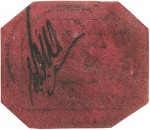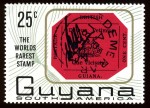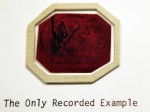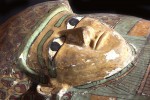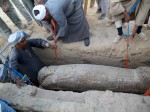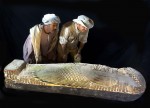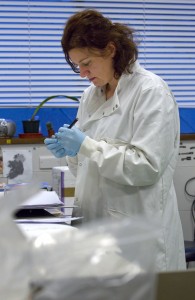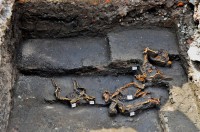 Archaeologists excavating underneath an apartment building in the Aztacapozalco neighborhood of Mexico City have unearthed an unusual group burial of 12 dogs dating to the Late Post Classic period of Aztec history (1350 to 1520 A.D.). Although dog burials are not in and of themselves uncommon in Aztec culture, these are unusual because they stand alone. Previous canine remains have been found in conjunction with human remains, or coupled with an important structure as sacrificial offerings. So far, archaeologists have found no human burials or building connected to any of the dogs.
Archaeologists excavating underneath an apartment building in the Aztacapozalco neighborhood of Mexico City have unearthed an unusual group burial of 12 dogs dating to the Late Post Classic period of Aztec history (1350 to 1520 A.D.). Although dog burials are not in and of themselves uncommon in Aztec culture, these are unusual because they stand alone. Previous canine remains have been found in conjunction with human remains, or coupled with an important structure as sacrificial offerings. So far, archaeologists have found no human burials or building connected to any of the dogs.
In the Aztec religion, dogs played important roles is rituals and mythology of the underworld. Dogs acted as guardians and escorts for their masters’ souls as they traveled to the underworld. The deity Xolotl, often depicted as dog-headed, created a dog specifically to aid the dead in their voyage. It was the Xoloitzcuintli, also known as the Mexican hairless dog, that Xolotl gave to humanity instructing them to guard the dogs during life in exchange for the dogs guiding them through the nine levels of Mictlan, the main underworld destination. Dogs also played a less sanctified role in Aztec culture: as a dietary protein supplement.
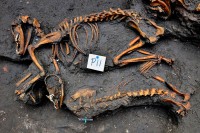 The remains were found between 4.2 feet and 5.5 feet under street level in a pit 6.5 feet square. They are in good condition, skeletons almost entirely intact and articulated. They don’t appear to have been laid to rest in any particular pattern or orientation, but they were buried all at one time on their sides. No artifacts were found in this pit. Ceramics discovered in other trenches around the dog burial provide a contextual date. Their black geometric designs on orange pottery identify the pottery as Aztec III style, household goods that were ubiquitous in Late Post Classic Mexico.
The remains were found between 4.2 feet and 5.5 feet under street level in a pit 6.5 feet square. They are in good condition, skeletons almost entirely intact and articulated. They don’t appear to have been laid to rest in any particular pattern or orientation, but they were buried all at one time on their sides. No artifacts were found in this pit. Ceramics discovered in other trenches around the dog burial provide a contextual date. Their black geometric designs on orange pottery identify the pottery as Aztec III style, household goods that were ubiquitous in Late Post Classic Mexico.
Michael E. Smith, an anthropology professor at Arizona State University who was not involved in the project, said the discovery is important because it is the first such find.
“This is not the first time a burial of a dog has been found, but it is the first find where many dogs were carefully buried together, in a setting that is like a cemetery,” Smith said.
[Archaeologist Rocio] Morales Sanchez said they will need to dig deeper to see if there are other items that could help them find out why the animals were buried in that area.
Smith said it will be important to see the results of the analysis of the bones.
“That work will tell us about the breed of these dogs, and it may tell us how they were killed,” he said. “The full significance of the finds is rarely obvious at time of excavation; the analysis will give the full story.”
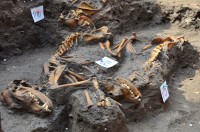 Osteological examination suggests these were common dogs, ie mutts, rather than one of the native pure breeds like the small Techichi and the hairless Xoloitzcuintle. The Techichi have unmissable short legs that none of the 12 dogs have and the Xoloitzcuintle lose their premolars in adulthood. The buried dogs were all adults at the time of death with full sets of teeth.
Osteological examination suggests these were common dogs, ie mutts, rather than one of the native pure breeds like the small Techichi and the hairless Xoloitzcuintle. The Techichi have unmissable short legs that none of the 12 dogs have and the Xoloitzcuintle lose their premolars in adulthood. The buried dogs were all adults at the time of death with full sets of teeth.
There’s some excellent footage of the excavation in this Spanish language video:
[youtube=http://youtu.be/u_SpPMvoPoM&w=430]
